

© words, photographs, Linden Wilkie, 2023
Bordeaux, or Burgundy?
My head still spinning from the inspirational visit to Harlan in the morning, the afternoon was devoted to BOND.
Can we call BOND Harlan’s sequel, or prequel? The genesis is the same epiphany Bill Harlan had on a trip to France suggeded by Bob Mondavi in November 1980. As recounted by Harlan’s founding winemaker Bob Levy, and covered in my report on visiting Harlan, that tour impressed upon Bill that if you want to make a “first growth”, the choice of land was absolutely critical, but so too was taking a long – inter-generational – view to incrementally realizing that potential quality.
When I imagine the inspiration for Harlan Estate, the image in my mind is of Bob Mondavi’s friend and collaborator, the Baron Philippe de Rothschild, who as a young man had been the first in his family to take a hands-on approach at the family’s Château Mouton-Rothschild. In 1980, Mouton had been in the Rothschild family’s hands already for 127 years, it having been purchased by Philippe’s great-grandfather, Nathaniel de Rothschild in 1853. That timing had proven poor luck in one respect – it was too late for the investments the Rothschilds subsequently made in the property to count when the 1855 Classification ranked Mouton “second growth”. Philippe – who arrived at Mouton in 1922, and insisted on 100% château-bottling from 1924, seems to have been quite aware of this. Mouton labels bore his motto - Premier ne puis, Second ne daigne, Mouton suis - “First, I cannot be, Second, I do not deign to be, Mouton I am.” Charm, ambition, a certain amount of intrigue perhaps, whatever the case in 1973 – 50 years into his helmsmanship – Château Mouton-Rothschild was upgraded to first growth by presidential decree, and the motto updated – Premier je suis, Second je fus, Mouton ne change, “First, I am, Second, I used to be, Mouton does not change.” Whatever the actual elements of inspiration that coalesced on that tour, by the end of 1980, Bill Harlan’s wine vision was clear: to create a Napa “first growth”. He needed Napa’s best site – perhaps one that didn’t yet exist as vineyard land (indeed, the site he purchased in 1984 was forest, without roads, water, or power). He also needed a very long-term view, one he codified into a “200 year plan”.
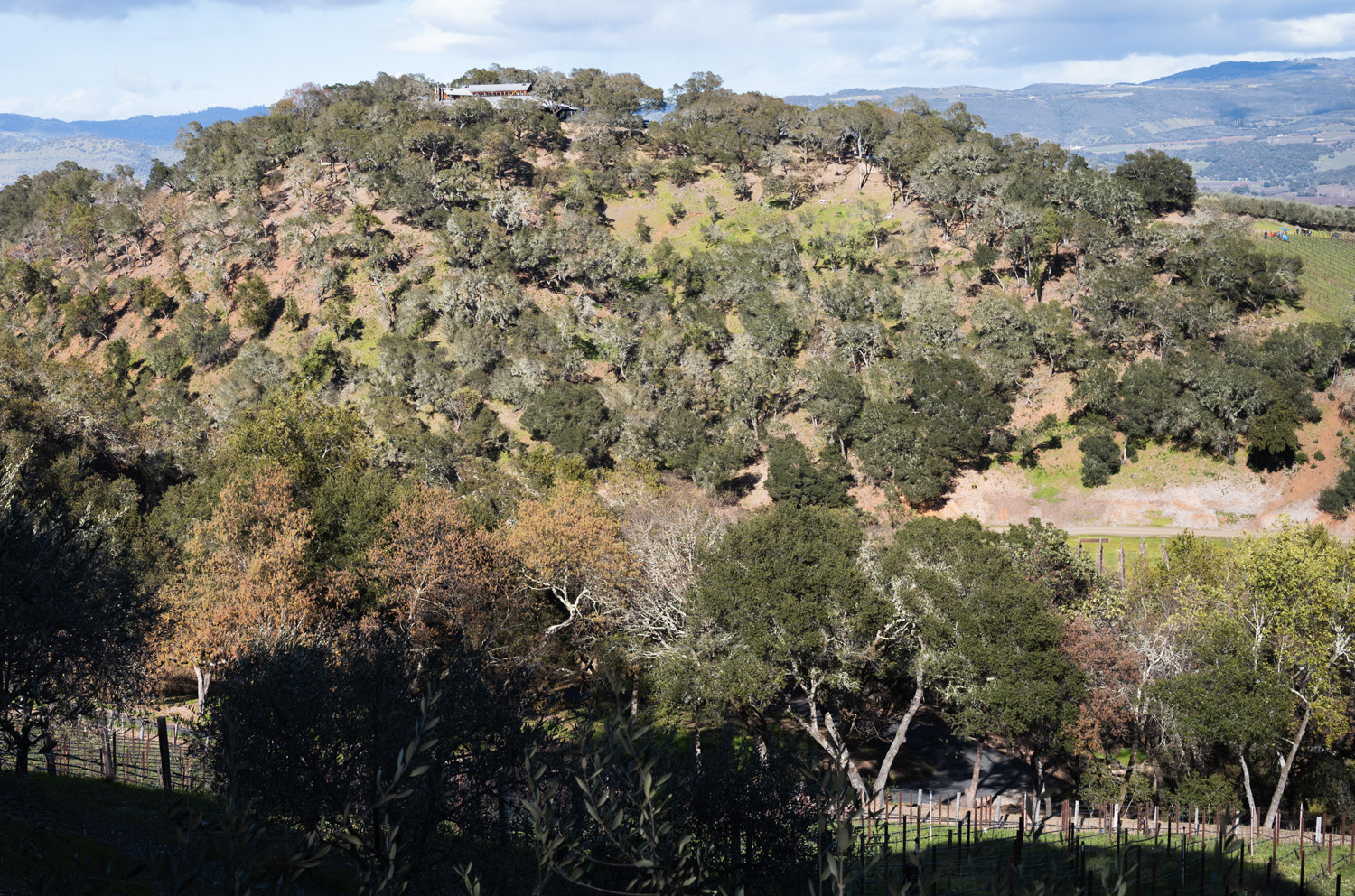
Same Seed, Different Branch
While it is easy to see a Mentzelopoulos (Margaux), Dillon (Haut-Brion), or Rothschild (Mouton, Lafite)-like inspiration for Harlan Estate, we should remember that the November 1980 tour began not in Bordeaux but in Burgundy. For Robert Mondavi, in wanting to create a charity auction in Napa to support healthcare, the inspiration was the Hospice de Beaune. At estates like the Domaine de la Romanée-Conti, Bill Harlan would have seen first hand another model for ‘best in class’ – a collection of complementary “grand crus”, each expressing something different through one grape variety, Pinot Noir.
The connection with Napa is less immediately obvious not only because the king of varietals in Napa is Cabernet Sauvignon, not Pinot Noir, but also because the importance of site isn’t given the limelight exclusively in the way it is in Burgundy. Burgundians almost never talk about Pinot Noir – only about terroir. At various tastings during an intense Napa Premiere programme, I heard winemakers present their wines discussing Cabernet clone selections and winemaking at least as much as they discussed site.
The concept that would evolve into BOND was not about “Cabernet Sauvignon”, even if that is the varietal key. Rather, that key is there to unlock and reveal the best of Napa Valley’s terroirs – its “grand crus”. Identifying grand crus in Burgundy has taken centuries of fine tuning. How could this be achieved in Napa? When Bob Levy began making wines with Bill Harlan for Merryvale in 1983, they were able to taste fruit from multiple growers and sites – valley floor, bench and mountain fruit, across the length and breadth of the valley. As BOND states today, ‘From more than sixty vineyards we have worked with over the past quarter century we have slowly and vigilantly selected five sites.’
Simple in Concept, Rewarding to Follow
Thinking about this from the wine-enthusiast side, Harlan Estate is the wine you can get to grips with quickly – a single estate, a blend and a vintage expression that might shift around year to year, but essentially one personality to get to know. BOND on the other hand takes time. With five sites (and they hope some day a sixth), there are five terroirs to come to terms with. This is closer to the experience of collecting wines from Burgundy, the Mosel or Piedmont – each year there is a matrix of vintage and multiple terroirs expressed through a grape variety, and so to Pinot Noir, Riesling and Nebbiolo, BOND adds Cabernet Sauvignon to this type of fine wine experience. If that is something that appeals to you in any one of those other regions, chances are this longer journey at BOND is going to appeal to you too.
My BOND Visit
BOND sits in the valley behind Harlan, so by now my friend Mike and I were pros at navigating off-grid. While Harlan feels secluded, and surrounded by nature, it also offers a commanding view of the most famous of Napa Valley sites below it – Martha’s Vineyard, To Kalon, and so on. But here at BOND, with the Harlan estate visible on the ridgeline beyond, the feeling is an order of magnitude more rural and secluded.
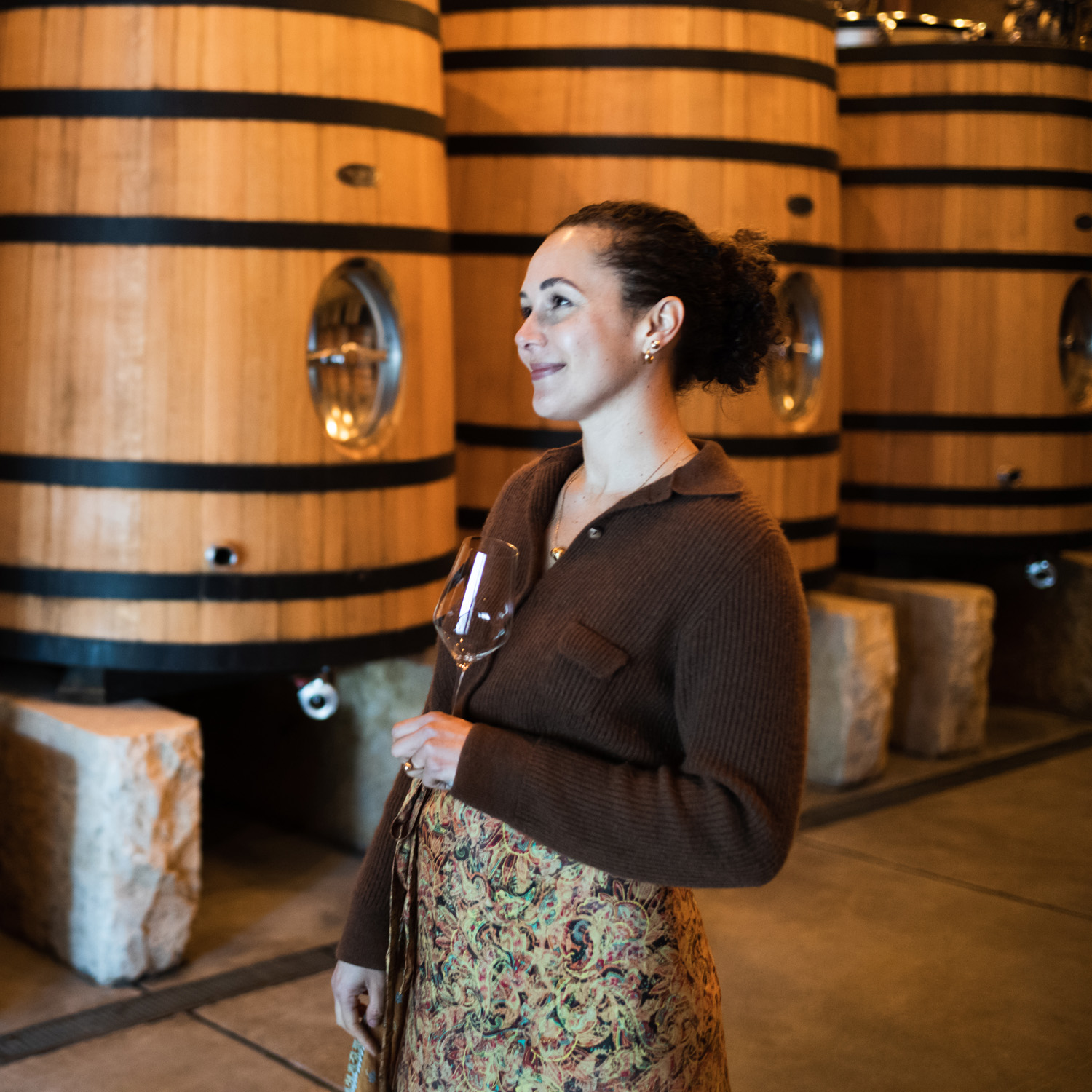 We are met by Lucy Tea Anderle, ambassador for BOND, with another glass of Krug to sip while we get our bearings and take in the view. (I could get used to this!) We make our introductions, and discuss what we are into, including in her charming words “the wines that nourish me and make me feel alive”, from around the world. Imbued with enthusiasm and an openness that feels so at home in sunny California, Lucy fine-tuned her passion for the world of wine while studying English literature at Oxford University, winning against Cambridge on the same wine tasting team as critic William Kelley while there. Not for the last time during this week in Napa I was reminded why I got into this whole wine thing in the first place, long long ago.
We are met by Lucy Tea Anderle, ambassador for BOND, with another glass of Krug to sip while we get our bearings and take in the view. (I could get used to this!) We make our introductions, and discuss what we are into, including in her charming words “the wines that nourish me and make me feel alive”, from around the world. Imbued with enthusiasm and an openness that feels so at home in sunny California, Lucy fine-tuned her passion for the world of wine while studying English literature at Oxford University, winning against Cambridge on the same wine tasting team as critic William Kelley while there. Not for the last time during this week in Napa I was reminded why I got into this whole wine thing in the first place, long long ago.
Pipette in hand, we follow Lucy into the cellar to taste from barrel.
2021 Quella
A clear fresh ruby; dark raspberry tone on the nose, sweet herb, a touch of earth and spice, there is a nice zing to the aroma; the palate is fine, fresh and supple, essency fruit with nice freshness, a touch of dark chocolate, cherry compote, and there’s a nod to something Italian and bittersweet, also a wet flower garden with its mix of florals and wet earth. This is elegant, a touch mineral – though not overly firm or tight in feel.
2021 Vecina
Fine clear deep ruby with a pink rim; this is bright and violetty on the nose, a little salty-toned, cherry-scented; the palate is more lush than the Quella, and it feels centred on the palate in a deep pool of luminous shining dark fruit, the texture beyond is velvet-fine.
Upstairs, a full horizontal tasting of the 2012 vintage has been prepared. Would I ‘find’ Quella and Vecina again?
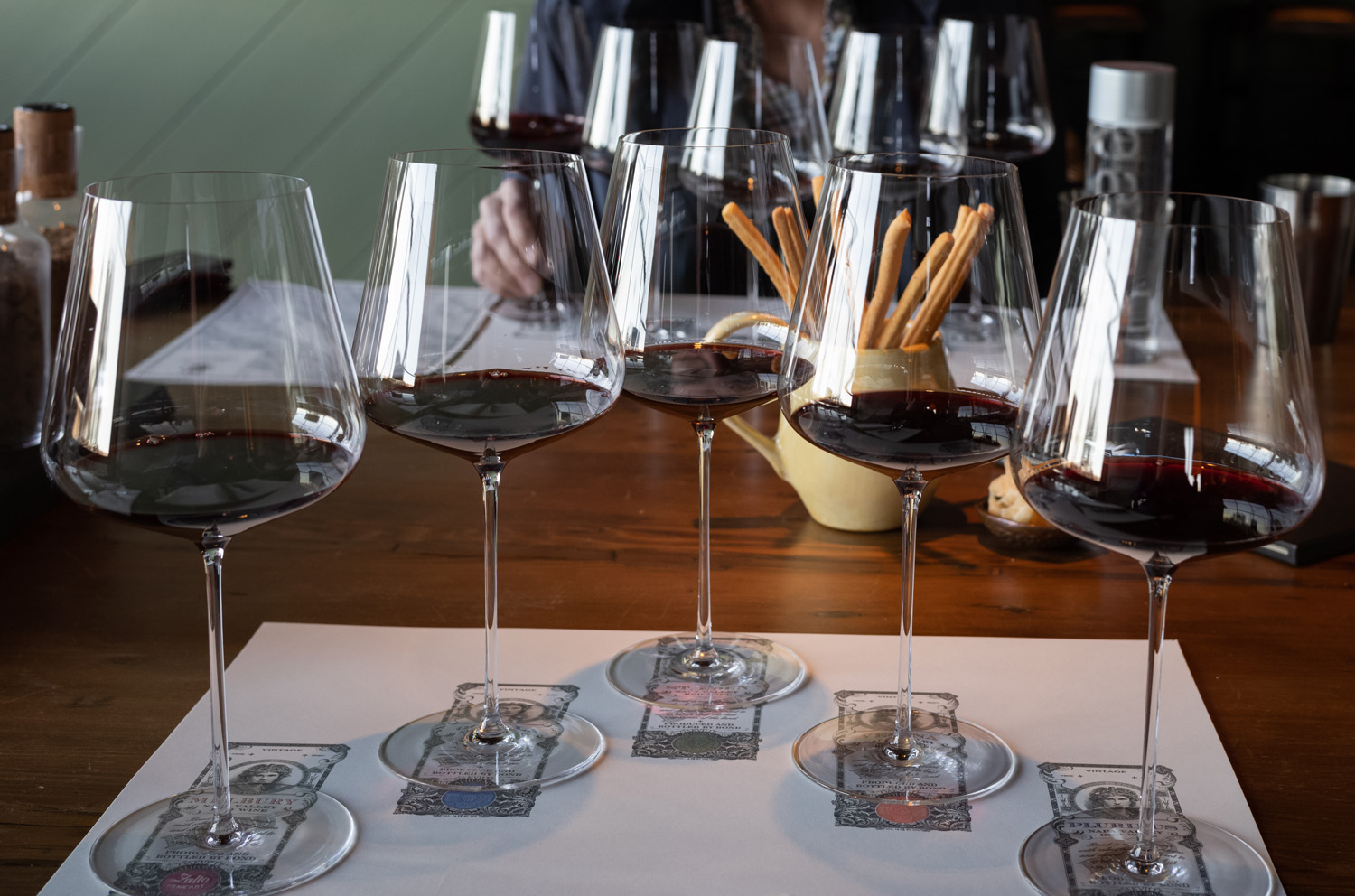
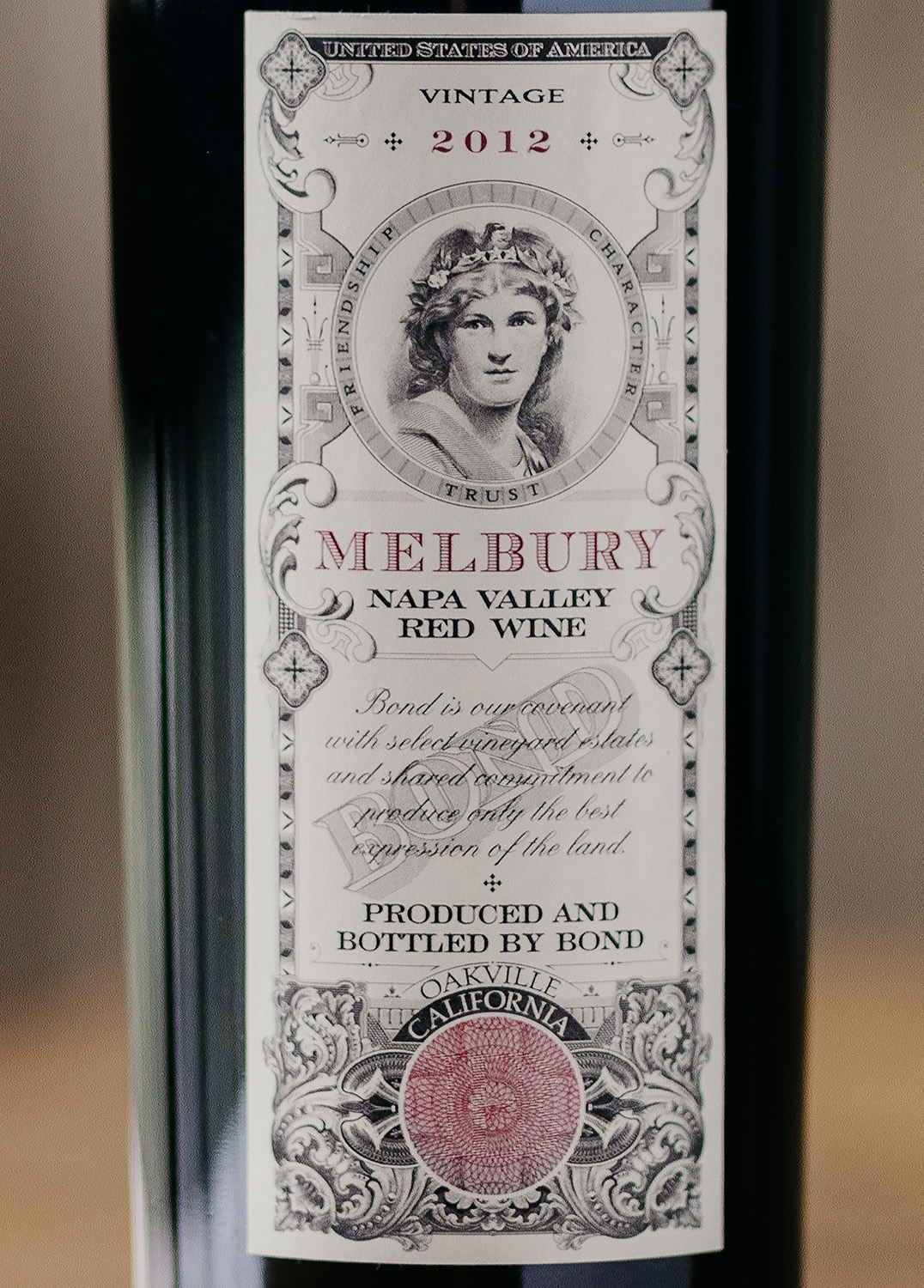 2012 BOND Melbury
2012 BOND Melbury
1999 debut vintage, from the slopes north of Lake Hennessey in the hills east of Rutherford. Ancient sedimentary soil with compressed clay. Eastern and south-eastern exposure, 348~522 feet elevation.
Deep semi-opaque garnet; an airy-fresh mountain herb scent overlays the bright fruit led by blackcurrant, notes of fine leather and mountain scrub; the palate offers a lush and melting entry, quite intense, with a sorbet fresh intensity and focus to the acidity, the fruit is plush, with a persistent expression through to the long finish. With another half an hour in the glass, returning to this I find it garden-fresh, very detailed and enthralling; this is elegant, complex and interesting to taste, drawing me into the glass. I want to stroll through this wine. It’s so charming, it’s the most airy of the five 2012s.
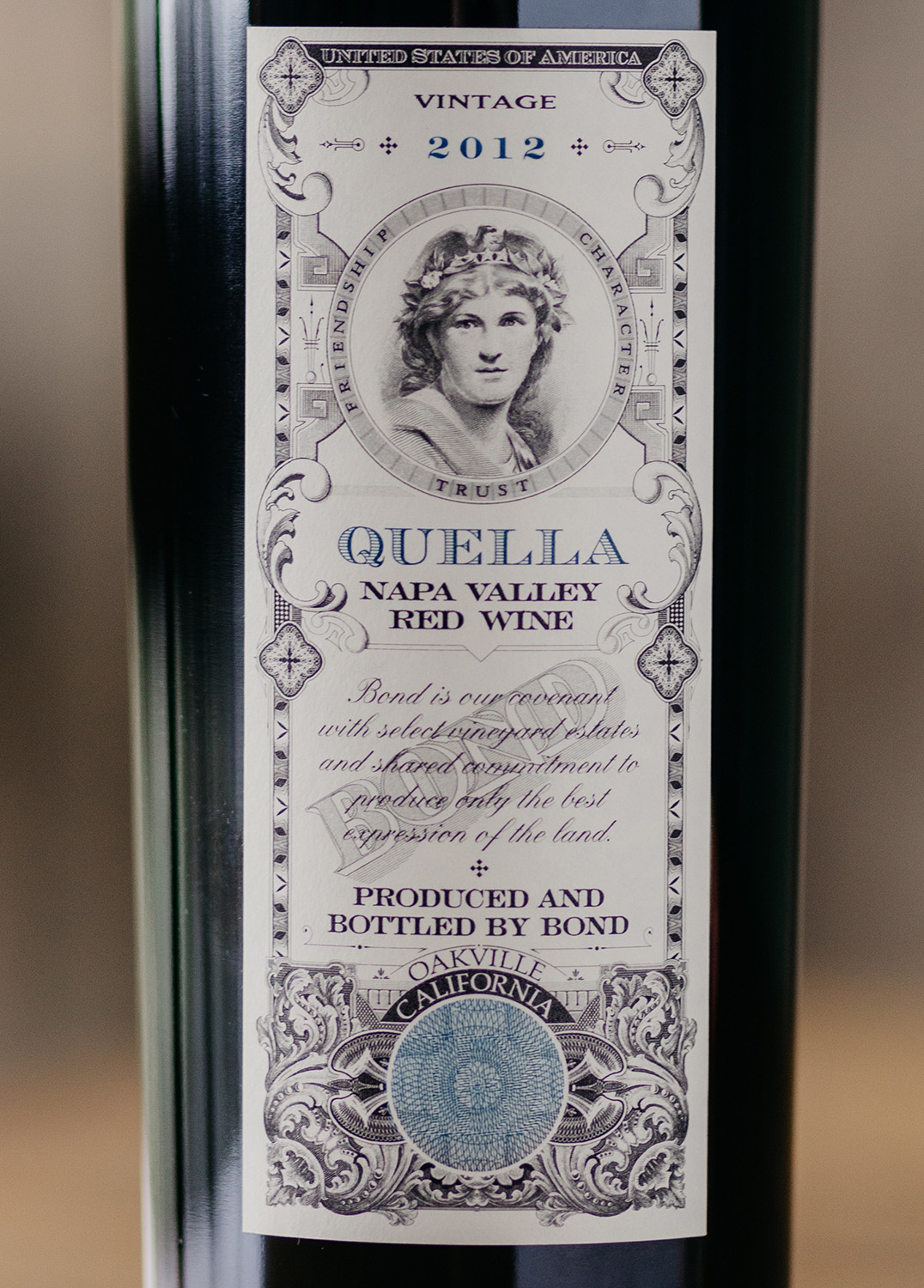 2012 BOND Quella
2012 BOND Quella
2006 debut vintage, eastern hills overlooking the heart of Napa Valley. Ancient uplifted riverbed covered with Tufa (volcanic qsh). Southwest exposure, 433~595 feet elevation.
Fine ruby-garnet; a spicy nose, quite negro-amaro, almost chinato in tone, though this is all also subtle, a plumpness of fruit implied in the aroma; the palate is open-textured, with a relaxed feeling palate coating fruit expression, a line of juiciness flows through the centre delivering a second layer of brightness in the expression, along with bittersweet herbs, and that builds and then flows out in the long finish. There are granular-fine tannins, a touch drier than some others (warmer site?). With another half an hour in the glass I notice a salty edge to the fruit, some minerality. This is so upbeat, a joyful wine.
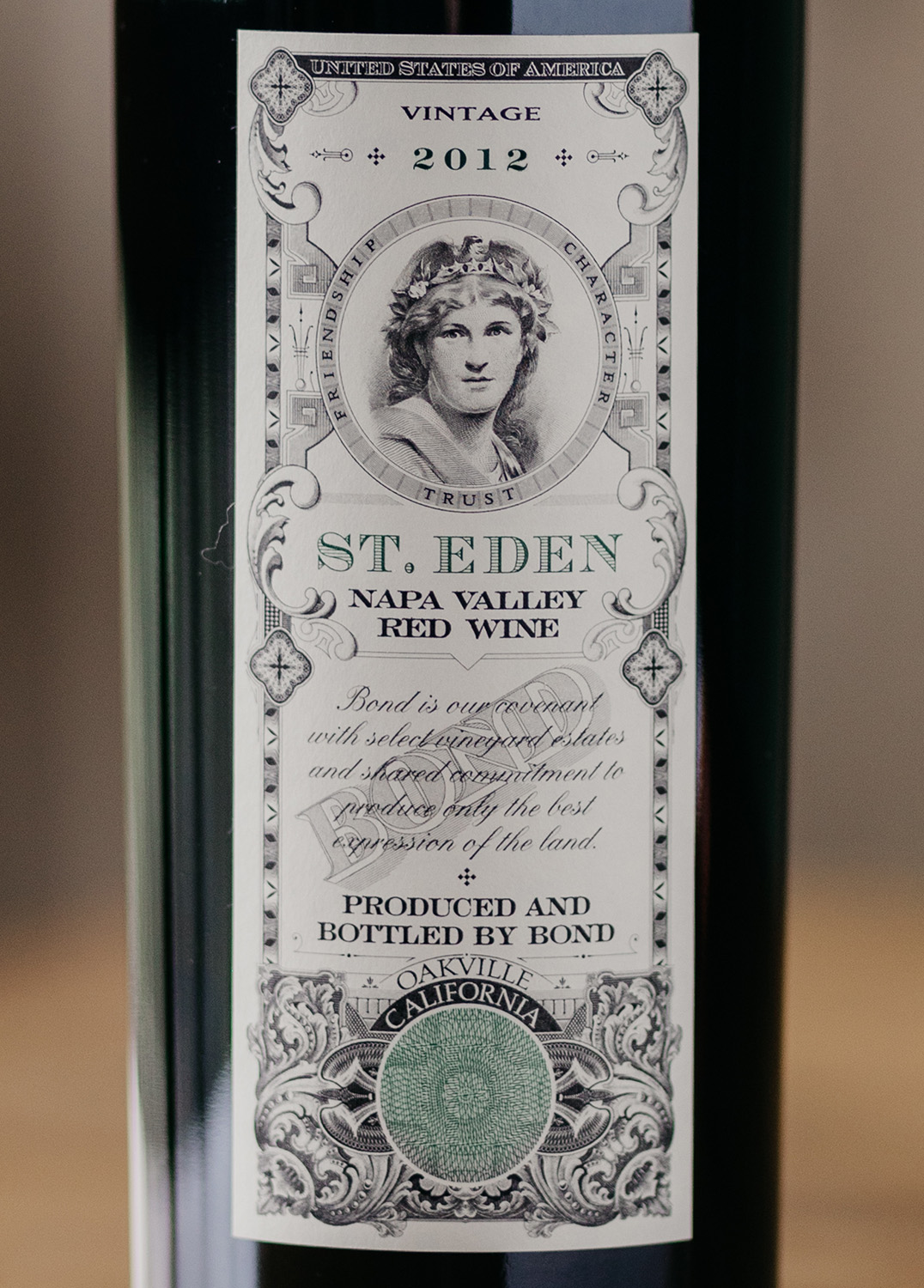 2012 BOND St. Eden
2012 BOND St. Eden
2001 debut vintage, a rocky knoll just north of the Oakville Crossroad. Iron-rich fractured volcanic rock from a landslide. Northern exposure, 145~188 feet elevation.
A fine-hued garnet; a bright top note of fresh mint gives a cooling tone to the elegant fruit, a hint of leather too in the aroma; this is lush and succulent on the palate, its flows in a column of fruit defined along the sides of the palate by fine tannins giving it a sculptured shape. There is a warm feel to the finish that is then flipped by the cool mint note that comes redux at the end. With another half an hour in the glass a note of milk chocolate emerges on the nose, it’s more spicy, with the mint now more in the background. The palate remains very well shaped and defined, it’s self-contained, mouthwatering.
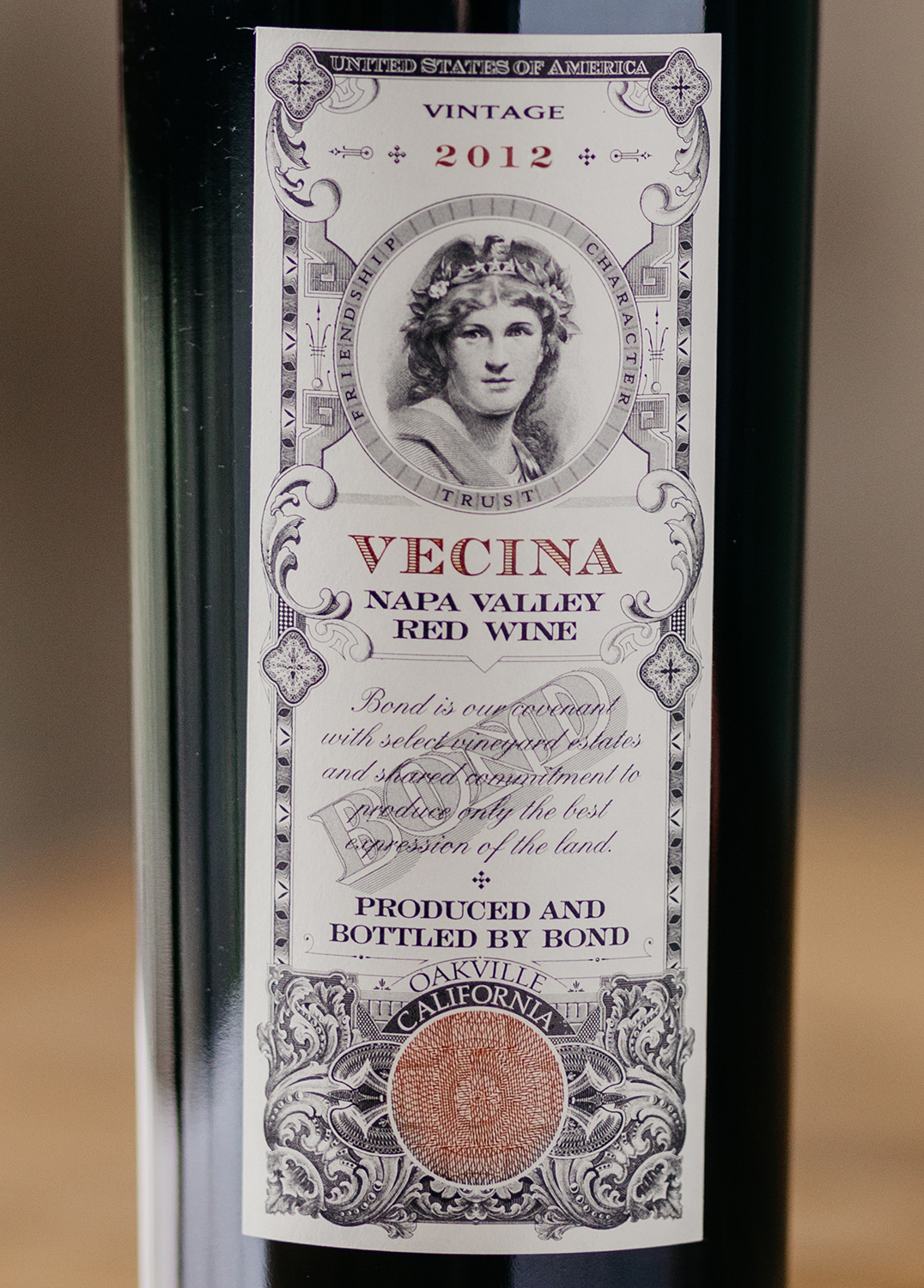 2012 BOND Vecina
2012 BOND Vecina
1999 debut vintage, a site directly southeast of the BOND winery, in Oakville’s western foothills. Terraced volcanic soil overlain with fine alluvial wash. Eastern exposure at 221~330 feet elevation.
A deeper tone and colour within this line up, fresh garnet; a more bass-tone nose, fruit and skins, ripe and aromatic; a lush feel, mouth-coating, the fruit really envelops the palate generously – like the ’21 just tasted from barrel. This also has more grip across the board than the other four, giving a more terrestrial tone – its feet are firmly on the soil. This gives this Vecina a some old school muscle, a fine yet slightly warmer finish too.
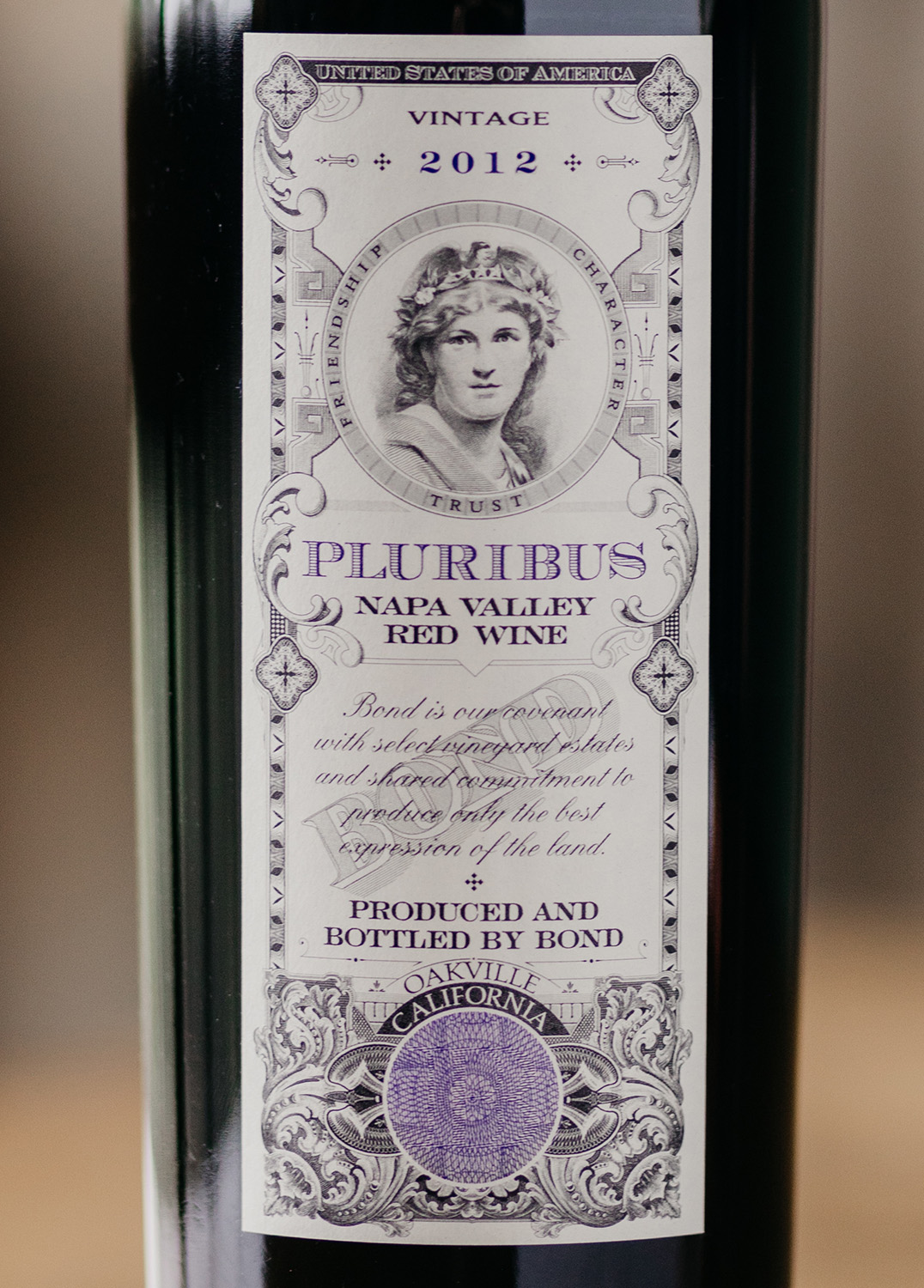 2012 BOND Pluribus
2012 BOND Pluribus
2003 debut vintage, Spring Mountain site, decomposed volcanic material surrounded by conifer forest, north and east exposure at 1,137~1,327 feet elevation. Deep semi-opaque garnet; a ripe, pure Cabernet Sauvignon expression – really varietal and precise, blackcurranty; the palate is intense, focused, pulled right in with an intense dark fruit tone. With air an umami-savoury counterpoint emerges offering complexity.
There’s a hint of candy, and the fruit is expressed on the palate in a riper register, with more intensity and thrust. It feels the boldest of the five. Having made that conclusion…. it changed the most of the five, during a further hour in the glass, first with a note of kampot pepper on the nose; then with a touch of earth on the palate, this wine ever so slowly unfurled, freshened in tone, and softened in texture. At this tasting, the dark horse of the five.
There’s always a rush, a thrill to tasting something new, especially when there are wines to compare on a theme, and the quality is good. But I recall at the end of this that I was really fizzing, and went way over the time I felt was reasonable (Lucy gave no clue of course!) to spend with these five glasses, and in discussion. They kept changing, like the most satisfying of wines do. Did I pin them down, did I know them by the finish? Not at all. But as a final comment in my notebook, I wrote ‘…but there is enough here to justify the BOND concept, and to lure me in to continue to get to know these five more.’ The satisfaction in taking the journey with BOND is that it will take a very long time to really get to know all five. That breadth might be the thing to choose – buying assortment packs each year for example. Or the journey might lead to finding personal favourites, and focusing in on those. In any case now – in Napa – I had found that same draw that I feel in Burgundy, Piedmont and the Mosel: the lure of high quality wine, amplified by the intrigue and satisfaction brought by discovering what specific terroirs can express. I’m left happy, but wanting to go deeper.
